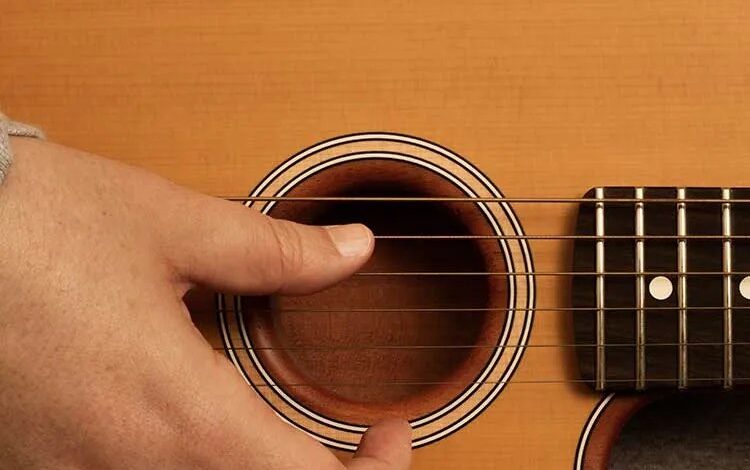Develop Rhythmic Independence in the Thumb to Help Free Your Groove

This fingerstyle lesson is about developing rhythmic independence for the picking-hand thumb. That process can be harder than it sounds—sometimes a lot harder. But the musical rewards are immense. These techniques can add cool and interesting variations to traditional picking patterns and open the door to funky new grooves, particularly ones from Africa and the Caribbean.
Four on the Floor?
Most popular acoustic fingerpicking styles share one trait: the thumb falls squarely on beats 1 and 3. For example, consider the technique often referred to as Travis picking. I grew up believing that was the sound I heard on folk-rock songs such as Simon and Garfunkel’s “The Boxer,” Fleetwood Mac’s “Landslide,” and Kansas’ “Dust in the Wind.” (Taylor Swift’s “Begin Again” is a more recent example.) In these songs the thumb plays a steady stream of on-the-beat notes, bouncing between a bass string and a treble string, while the picking hand’s second and third fingers play off-beat rhythms that complement the steady thumb.
Eventually I heard the style as actually played by its namesake, Merle Travis. He used only a thumbpick and index finger. He was ridiculously good—check out videos for such songs as “Nine Pound Hammer” and “Lost John” as evidence.
For playing in the alternating bass style, some players grip a flatpick and use their third and fourth fingers in lieu of the second and third. In any case, the thumb (or pick) notes still fall squarely on the beats while only the fingers syncopate. (Syncopation means an accent that falls somewhere other than on the main beats.) This approach comes from ragtime piano, where the left hand plays straight rhythms, often bouncing between octaves, while the right hand syncopates. It’s a beautiful technique that can make beginning players sound advanced and advanced players sound sublime. It has inspired countless great songs.
But if you consider the rhythm from a drummer’s perspective, it’s as if the bass drum plays steady quarter notes on every song. Wouldn’t it be nice to mix things up sometimes? So let’s subvert that four-square feel.
Give It a Push
Example 1 shows a popular version of the alternating-bass style. The thumb bounces between the fifth and third strings, playing strictly downbeats. But what if we add a “push”? (That’s pop music slang for an accent placed an eighth or 16th note before the expected beat.) In Example 2, the pair of notes you expect to hear on beat 3 appears on the fourth 16th note of beat 2. Those pushed notes sustain across beat 3, where nothing is played. Note the change of feel!
Let’s take it further. Example 3 has the same push as Ex. 2, but then the following notes are shifted forward by a 16th note. This pattern may sound awkward on its own, but Example 4 shows one way to use it in context. The straight Ex. 1 rhythm appears in bars 1 and 3. Bar 2 features the Ex. 2 rhythm, and bar 4 employs the slightly disorienting Ex. 3 rhythm. This works as a cool turnaround—think of it as a drum fill before the simpler pattern returns on the downbeat of the repeat.
These examples introduce the idea of placing thumb accents in unexpected places. Now let’s move on from alternating-bass picking and see how unexpected bass rhythms work in some funkier styles.
Caribbean Cool
In old-school calypso from Trinidad and Tobago, the rhythm guitar strums a steady stream of 16th notes—except on the beats. If you verbalize 16th notes as “one-ee-and-uh, two-ee-and-uh,” you omit the numbers but include the other three syllables. Meanwhile, traditional calypso bassists often play eighth notes on beats 2 and 4, but lay out on beats 1 and 3. Example 5 combines those two rhythms. Note that nothing falls directly on beat 1 or 3. It’s the opposite of the traditional Travis feel!
Those syncopations are even more extreme in Afro-Cuban music. In Ex. 6 the thumb plays tumbao, the super syncopated bass pattern that practically defines Latin music, from ancient rumba to modern salsa. As in Ex. 5, the fingers play a repeating three-note pattern, only this time on the beat.
Straight Out of Lagos
Let’s conclude with an African example based on the Afrobeat groove devised by Nigerian bandleader Fela Kuti (Example 7). We’re approximating this highly syncopated style via a typical Afrobeat bass line and the incessant offbeat pattern often played by claves and congas.
We’ve barely lifted the lid on a deep topic. But getting these patterns under your fingers may help you rethink the thumb’s role in fingerstyle grooves. Of course, there’s nothing wrong with non-syncopated thumb notes! But in the future you might choose that approach because it’s your best option—not your only one. With luck, developing a freer, funkier thumb will add interest and variation to the picking patterns you know and unlock countless new ones.



This article originally appeared in the March/April 2024 issue of Acoustic Guitar magazine.



